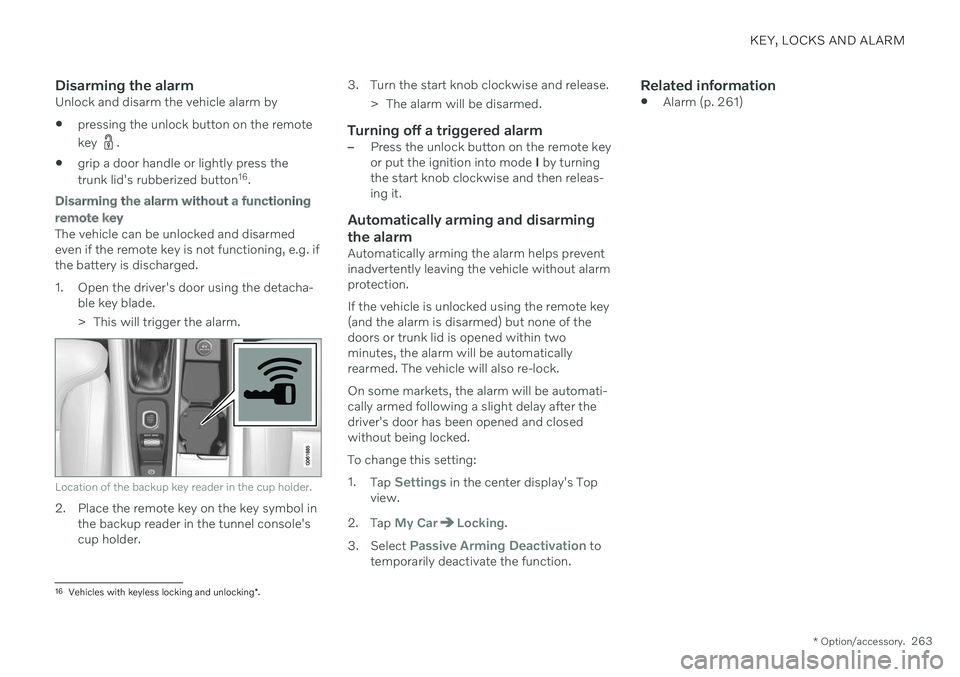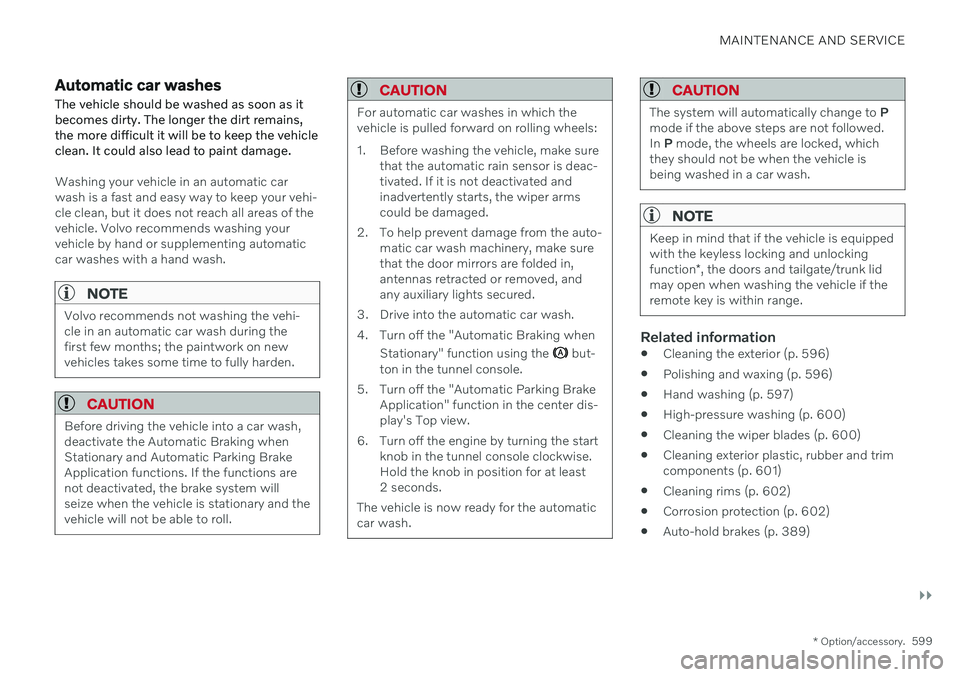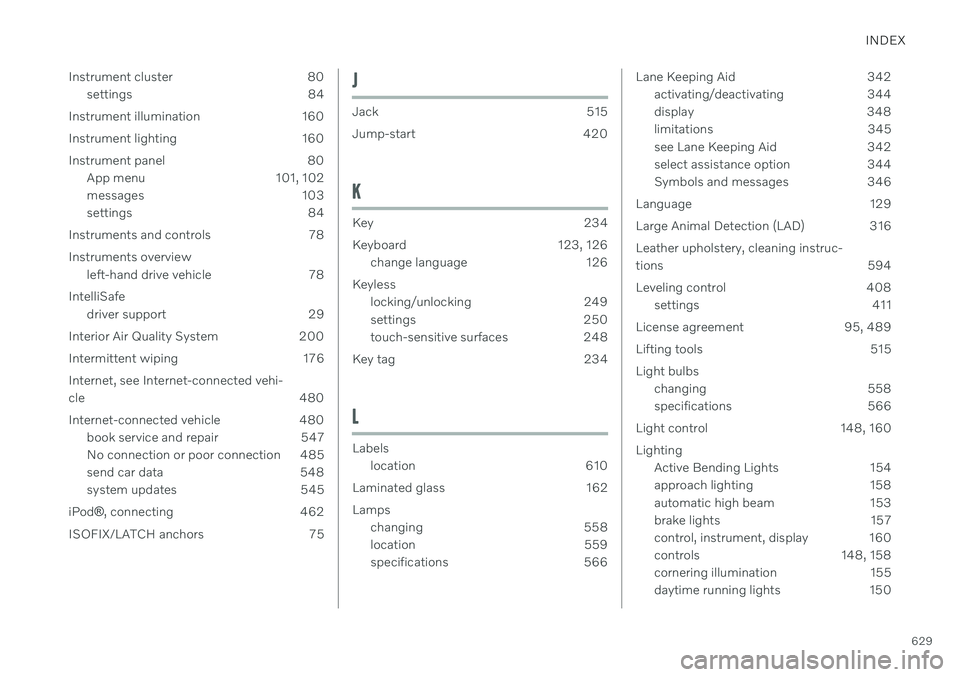keyless VOLVO S90 2020 Quick Guide
[x] Cancel search | Manufacturer: VOLVO, Model Year: 2020, Model line: S90, Model: VOLVO S90 2020Pages: 643, PDF Size: 13.68 MB
Page 260 of 643

||
KEY, LOCKS AND ALARM
* Option/accessory.
258
Closing and locking
–Press the button on the lower edge of
the trunk lid to close and simultaneously lock 14
both the trunk lid and doors (all
doors must be closed in order to lock).
> The trunk lid closes automatically – the trunk lid and doors lock, and the alarm is armed.
NOTE
One of the vehicle's remote keys must be within range for locking and unlock-ing to be possible.
When the keyless locking or closing
*
functions are used, three audible signals
will sound if the key is not detected close enough to the tailgate.
CAUTION
When operating the trunk lid manually, open and close it slowly. If you encounterresistance, do not use force. This couldlead to damage and loss of function.
Interrupting closingInterrupt closing by doing one of the follow- ing:
Press the button on the dashboard.
Press the button on the remote key.
Press the close button on the underside ofthe trunk lid.
Press the rubberized pressure plate on theunderside of the tailgate's outer handle.
Using a foot movement
*.
The trunk lid will stop closing and return to itsfully open position. The trunk lid can then beopened or closed manually.
Pinch protectionIf anything obstructs the tailgate with enoughforce to prevent it from closing, pinch protec-tion will be activated.
The trunk lid will stop and then return toits fully open position. A long audible sig-nal will sound.
WARNING
Be aware of the risk of serious injury when operating the trunk lid. Before opening or closing, make sure that no one is near the trunk lid's range ofmotion. Serious injury could occur. Always operate the trunk lid with caution.
Related information
Opening and closing the trunk lid with foot movement
* (p. 259)
Remote key range (p. 237)
14
Vehicles equipped with keyless locking and unlocking * have a button for closing and a button for closing and locking.
Page 261 of 643

KEY, LOCKS AND ALARM
* Option/accessory.259
Opening and closing the trunk lid with foot movement *
To make it easier to operate the trunk lid when your hands are full, it can be openedand closed by moving your foot in a forwardkicking motion under the rear bumper.
The sensor is located to the left of center under the rear bumper.
One of the vehicle's remote keys must be within range behind the vehicle, approx. 1meter (3 feet), for opening and closing to bepossible. This applies even if the vehicle isunlocked in order to prevent the trunk lid frominadvertently opening e.g. at a car wash.
Foot movement operation
Kicking motion within the sensor's activation area.
–Make one slow forward kicking motion
with your foot under the left section of the rear bumper. Take a step back. Do nottouch the bumper.
> A brief audible signal will sound when opening or closing is activated - the trunk lid will open/close.
If several opening or closing attempts havebeen made without the remote key in rangebehind the vehicle, foot movement operationwill not be available for a short period of time. Do not keep your foot under the vehicle in a kicking motion. This may prevent activation.
Interrupting foot movement operation
–Make one slow forward kicking motion
while the trunk lid is opening/closing to stop its movement.
> The trunk lid will stop closing and return to its fully open position. The trunk lid can then be opened or closedmanually.
The remote key does not need to be withinrange of the vehicle to interrupt closing.
NOTE
There is a risk of reduced or lost function if there are large amounts of snow, ice, dirt,etc. on the rear bumper. Make sure to keepthe bumper clean.
NOTE
Please note that the system could be inad- vertently activated in a car wash or similarif the remote key is within range.
Related information
Keyless and touch-sensitive surfaces
*
(p. 248)
Opening and closing the power trunk lid
*
(p. 256)
Remote key range (p. 237)
Page 264 of 643

||
KEY, LOCKS AND ALARM
* Option/accessory.
262
Alarm indicator
A red indicator light on the dashboard shows the status of the alarm:
Indicator off - the alarm is disarmed.
Indicator flashes once every two seconds -the alarm is armed.
The indicator flashes quickly after thealarm has been disabled for up to30 seconds or until the ignition is put in
I
mode – the alarm has been triggered.
In the event of alarm system failureIf a problem is detected in the alarmsystem, a symbol and the message
Alarm system failure Service
required will appear in the instru-
ment panel. Contact a workshop - an author- ized Volvo workshop is recommended.
NOTE
Do not attempt to repair or alter any of the components in the alarm system yourself.Any such attempt could affect the termsand conditions of your insurance policy.
Related information
Arming and disarming the alarm (p. 262)
Arming and disarming the alarm
The alarm is armed when the vehicle is locked.
Arming the alarmLock and arm the vehicle by
pressing the lock button on the remote key
.
touch the marked surface on the outside of the door handle or the rubberized pres- sure plate on the trunk lid 16
.
If the vehicle is equipped with both keyless locking/unlocking * and power trunk lid, the
button
on the lower edge of the trunk lid
can also be used to lock and arm the vehicle.
A red LED light on the dashboard will flash every other second when the vehicle is locked and thealarm is armed.
Page 265 of 643

KEY, LOCKS AND ALARM
* Option/accessory.263
Disarming the alarmUnlock and disarm the vehicle alarm by
pressing the unlock button on the remote key
.
grip a door handle or lightly press the trunk lid's rubberized button 16
.
Disarming the alarm without a functioning
remote key
The vehicle can be unlocked and disarmed even if the remote key is not functioning, e.g. ifthe battery is discharged.
1. Open the driver's door using the detacha- ble key blade.
> This will trigger the alarm.
Location of the backup key reader in the cup holder.
2. Place the remote key on the key symbol inthe backup reader in the tunnel console's cup holder. 3. Turn the start knob clockwise and release.
> The alarm will be disarmed.
Turning off a triggered alarm–Press the unlock button on the remote key or put the ignition into mode I by turning
the start knob clockwise and then releas-ing it.
Automatically arming and disarming the alarm
Automatically arming the alarm helps prevent inadvertently leaving the vehicle without alarmprotection. If the vehicle is unlocked using the remote key (and the alarm is disarmed) but none of thedoors or trunk lid is opened within twominutes, the alarm will be automaticallyrearmed. The vehicle will also re-lock. On some markets, the alarm will be automati- cally armed following a slight delay after thedriver's door has been opened and closedwithout being locked. To change this setting:1. Tap
Settings in the center display's Top
view.
2. Tap
My CarLocking.
3. Select
Passive Arming Deactivation to
temporarily deactivate the function.
Related information
Alarm (p. 261)
16
Vehicles with keyless locking and unlocking *.
Page 380 of 643

STARTING AND DRIVING
* Option/accessory.
378
Starting the vehicle
The vehicle can be started using the start knob in the tunnel console when the remotekey is in the passenger compartment.
Start knob in the tunnel console.
WARNING
Before starting:
Buckle your seat belt.
Adjust the seat, steering wheel and mirrors.
Make sure you can fully depress thebrake pedal.
The remote key is not physically used to startthe ignition because the vehicle is equippedwith the keyless Passive Start system. To start the vehicle:
1. The remote key must be inside the vehicle.
For vehicles with Passive Start, the key must be in the front section of the passen-ger compartment. With the optional key- less locking/unlocking function *, the key
can be anywhere in the vehicle.
2. Press and hold down the brake pedal 1
as
far as possible.
3. Turn the start knob clockwise and release. The control will automatically return to the original position.
WARNING
Never use more than one inlay mat at a time on the driver's floor. If any othertype of floor mat is used, remove theoriginal mat from the driver's seat floorbefore driving. All types of mats mustbe securely anchored in the attach-ment points in the floor. Make sure thefloor mat does not impede the move-ment of the brake pedal or acceleratorpedal in any way, as this could be aserious safety hazard.
Volvo's floor mats are specially manu-factured for your vehicle. They must beproperly secured in the attachmentpoints in the floor to help ensure theycannot slide and become trappedunder the pedals.
The starter motor will crank until the enginestarts or until overheating protection is trig-gered.
Error messagesIf the Vehicle key not found message is
shown in the instrument panel at start, place the remote key at the backup reader and thenmake a new start attempt.
1 If the vehicle is moving, it is only necessary to turn the start knob clockwise to start the engine.
Page 601 of 643

MAINTENANCE AND SERVICE
}}
* Option/accessory.599
Automatic car washes
The vehicle should be washed as soon as it becomes dirty. The longer the dirt remains,the more difficult it will be to keep the vehicleclean. It could also lead to paint damage.
Washing your vehicle in an automatic car wash is a fast and easy way to keep your vehi-cle clean, but it does not reach all areas of thevehicle. Volvo recommends washing yourvehicle by hand or supplementing automaticcar washes with a hand wash.
NOTE
Volvo recommends not washing the vehi- cle in an automatic car wash during thefirst few months; the paintwork on newvehicles takes some time to fully harden.
CAUTION
Before driving the vehicle into a car wash, deactivate the Automatic Braking whenStationary and Automatic Parking BrakeApplication functions. If the functions arenot deactivated, the brake system willseize when the vehicle is stationary and thevehicle will not be able to roll.
CAUTION
For automatic car washes in which the vehicle is pulled forward on rolling wheels:
1. Before washing the vehicle, make sure that the automatic rain sensor is deac- tivated. If it is not deactivated andinadvertently starts, the wiper armscould be damaged.
2. To help prevent damage from the auto- matic car wash machinery, make surethat the door mirrors are folded in,antennas retracted or removed, andany auxiliary lights secured.
3. Drive into the automatic car wash.
4. Turn off the "Automatic Braking when Stationary" function using the
but-
ton in the tunnel console.
5. Turn off the "Automatic Parking Brake Application" function in the center dis- play's Top view.
6. Turn off the engine by turning the start knob in the tunnel console clockwise.Hold the knob in position for at least2 seconds.
The vehicle is now ready for the automaticcar wash.
CAUTION
The system will automatically change to P
mode if the above steps are not followed. In P mode, the wheels are locked, which
they should not be when the vehicle isbeing washed in a car wash.
NOTE
Keep in mind that if the vehicle is equipped with the keyless locking and unlocking function *, the doors and tailgate/trunk lid
may open when washing the vehicle if the remote key is within range.
Related information
Cleaning the exterior (p. 596)
Polishing and waxing (p. 596)
Hand washing (p. 597)
High-pressure washing (p. 600)
Cleaning the wiper blades (p. 600)
Cleaning exterior plastic, rubber and trim components (p. 601)
Cleaning rims (p. 602)
Corrosion protection (p. 602)
Auto-hold brakes (p. 389)
Page 602 of 643

MAINTENANCE AND SERVICE
* Option/accessory.
600
Settings for automatically activating the parking brake (p. 387)
Keyless and touch-sensitive surfaces
*
(p. 248)
High-pressure washing The vehicle should be washed as soon as it becomes dirty. The longer the dirt remains,the more difficult it will be to keep the vehicleclean. It could also lead to paint damage.Wash the vehicle in a car wash or garagewith an oil separator. Use a car washingdetergent.
If washing the vehicle with a high-pressure wash, use sweeping movements and keep thenozzle at least 30 cm (13 in.) from the vehicle.Do not spray directly onto locks.
Related information
Cleaning the exterior (p. 596)
Polishing and waxing (p. 596)
Hand washing (p. 597)
Automatic car washes (p. 599)
Cleaning the wiper blades (p. 600)
Cleaning exterior plastic, rubber and trimcomponents (p. 601)
Cleaning rims (p. 602)
Corrosion protection (p. 602)
Cleaning the wiper blades The vehicle should be washed as soon as it becomes dirty. The longer the dirt remains,the more difficult it will be to keep the vehicleclean. It could also lead to paint damage.Wash the vehicle in a car wash or garagewith an oil separator. Use a car washingdetergent.
Asphalt, dust and salt residue on wiper blades, as well as insects, ice etc. on the windshield,shorten the service life of wiper blades. When cleaning, put the wiper blades in the service position.
NOTE
Wash the wiper blades and windshield regularly with a lukewarm soap solution orvehicle shampoo. Do not use strong sol-vents.
Related information
Cleaning the exterior (p. 596)
Polishing and waxing (p. 596)
Hand washing (p. 597)
Automatic car washes (p. 599)
High-pressure washing (p. 600)
Cleaning exterior plastic, rubber and trim components (p. 601)
Page 631 of 643

INDEX
629
Instrument cluster 80
settings 84
Instrument illumination 160
Instrument lighting 160
Instrument panel 80 App menu 101, 102
messages 103
settings 84
Instruments and controls 78 Instruments overview left-hand drive vehicle 78
IntelliSafe driver support 29
Interior Air Quality System 200
Intermittent wiping 176 Internet, see Internet-connected vehi- cle 480
Internet-connected vehicle 480 book service and repair 547
No connection or poor connection 485
send car data 548
system updates 545
iPod ®
, connecting 462
ISOFIX/LATCH anchors 75
J
Jack 515
Jump-start 420
K
Key 234
Keyboard 123, 126 change language 126
Keyless locking/unlocking 249
settings 250
touch-sensitive surfaces 248
Key tag 234
L
Labels location 610
Laminated glass 162 Lamps changing 558
location 559
specifications 566
Lane Keeping Aid 342activating/deactivating 344
display 348
limitations 345
see Lane Keeping Aid 342
select assistance option 344
Symbols and messages 346
Language 129
Large Animal Detection (LAD) 316Leather upholstery, cleaning instruc-
tions 594
Leveling control 408 settings 411
License agreement 95, 489
Lifting tools 515 Light bulbs changing 558
specifications 566
Light control 148, 160 Lighting Active Bending Lights 154
approach lighting 158
automatic high beam 153
brake lights 157
control, instrument, display 160
controls 148, 158
cornering illumination 155
daytime running lights 150